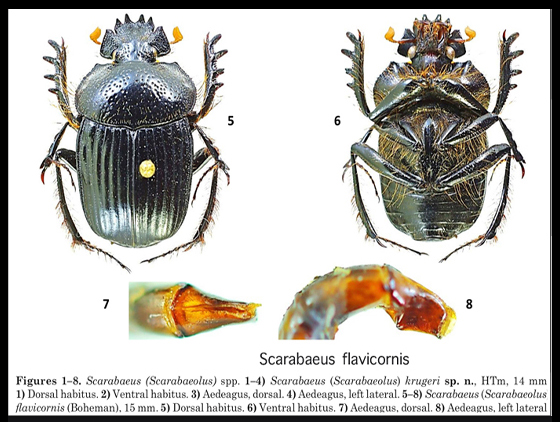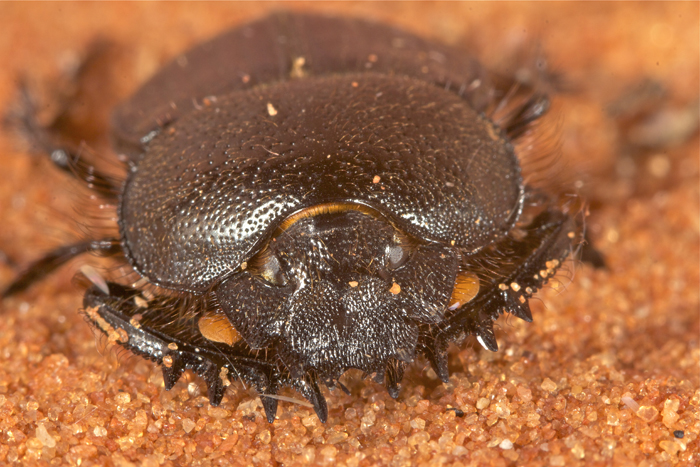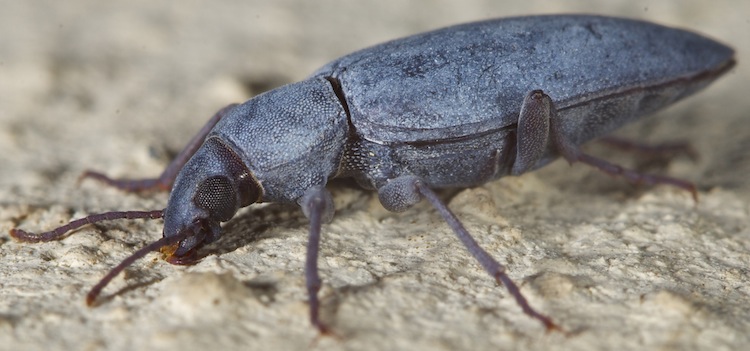Insect or Invertebrates Identification - DONE
Moderator: Klipspringer
- Lisbeth
- Site Admin
- Posts: 65762
- Joined: Sat May 19, 2012 12:31 pm
- Country: Switzerland
- Location: Lugano
- Contact:
Re: Insect or Invertebrates Identification
They are fascinating 
"Education is the most powerful weapon which you can use to change the world." Nelson Mandela
The desire for equality must never exceed the demands of knowledge
The desire for equality must never exceed the demands of knowledge
Re: Insect or Invertebrates Identification
I'll write it up as that and you can improve upon it (unless you've already written up the entry), agreed?
-
Klipspringer
- Global Moderator
- Posts: 5858
- Joined: Sat Sep 14, 2013 12:34 pm
- Country: Germany
- Contact:
Re: Insect or Invertebrates Identification
Please do
Description:
Large nocturnal telecoprid (ball-rolling) dung beetle.
Habitus black. Elytra flat, not prominently striated. Antennae orange.
Found in arid regions, Kalahari deep sands, outliers to east, Central Namib Desert, SW coast; South Africa, Namibia, Botswana, Zambia.
The recorded range of this species is from Lamberts Bay [32° 5’S 18°19’E] in the south (South Africa) to Liuwa plains [14°38’S 22°37’E] in the north (Zambia).
https://repository.up.ac.za/bitstream/h ... sAllowed=y
Scarabaeini
Taxonomy and morphology: The Scarabaeini comprise three genera, Scarabaeus, with 136 species, Pachylomera with two, and Pachysoma with
13 species. The tribe is characterized by members with the anterior margin of the head, which is sexdentate, comprising the quadridentate anterior margin of the clypeus and two lateral teeth formed by the anterior angles of the genae. Th e beetles have long legs for ball- rolling and/or fast running. Th e tibiae of the forelegs are quadridentate, although the proximal tooth may be represented by only a vestige. There are no fore tarsi. The species are mainly black although some show either red elytra or red patches on the elytra (some Scarabaeus, Pachysoma). A few are metallic-coloured (some Kheper). They vary in size from quite small (7.0 mm) to very large (48.5 mm).
Most of the species fly strongly but a number of desert taxa are flightless (including all the Pachysoma species).
Scarabaeus comprises four subgenera, the nominate subgenus, Kheper, Scarabaeolus and Sceliages.
The Scarabaeini comprise primarily coprophagous species. Th ey may be readily attracted to many dung types, or more specialized, with some also strongly attracted to carrion. Most species are active by day but some Scarabaeus, Scarabaeolus and Kheper are night-active. Whereas flightless species drag pellets and detritus, most flying species engage in ball-making and ball-rolling.
If ball-making and ball-rolling species form pairs at the dung, the males roll the ball with the female clinging to the side (Kheper, Scarabaeus (Scarabaeus)) or following behind (Scarabaeolus). When large numbers of Scarabaeini are active there is frequently combat between early arrivals at a dropping that have completed a ball and late arrivals that attempt to take possession of this ball. During such encounters, the object is to dislodge the incumbent from its defensive position on top of the ball or to deter the attacker by using the front legs to lift and flip the opponent away.
The ball may be rolled some distance before being buried in a burrow where it is used either for feeding or breeding.
Once a suitable pile of dung has been located, some species quickly sculpt a piece into a ball and start to roll it away along a straight path. The end destination for the ball is, at this point, unknown. The straight-line departure helps to minimize the time that the dung beetle spends near the dung pat, where foraging conspecifics congregate and frequently try to steal a ready-made ball. After some distance, the beetle finds a suitable patch of ground and buries itself together with its ball of dung. The ball is then slowly consumed in the safety of the ground.
Leaving a defined place might at first glance seem simple but is, as it turns out, impossible without an external directional reference—i.e. some form of compass. This is true even for ensuring progress away from a dung pile. Foraging dung beetles use a number of celestial compass cues to guide them along their straight tracks: the sun, the moon, the pattern of polarized light and even the Milky Way.
Nests of most Scarabaeini (Kheper, Scarabaeus (Scarabaeus)) comprise a chamber at the end of the burrow in which one or more brood pears are constructed and tended by the parent female.
Flight activity patterns may be related to the cooler conditions under which most species have been observed to fly, i.e. in the middle of the day under cooler conditions, but in the early morning, late afternoon, or at night under warmer conditions and, especially, after rainfall with its cooling effect on daily temperatures. At least some species are able to raise their body temperatures, enabling them to fly and exploit dung under cooler conditions.
Scarabaeolus:
Although recognition of the subgenus is not universal, of the 27 Scarabaeolus species, currently known, 24 show a regionally restricted distribution pattern centred on southern and southern central Africa. Furthermore, one observation of a Scarabaeus (Scarabaeolus) bohemani female following a male rolling a ball suggests that members of the subgenus may also show behavioral differences to Scarabaeus (Scarabaeus) species in which the female clings to the side of a ball being rolled by the male.
Re: Insect or Invertebrates Identification
I'll post what I have tomorrow here, so you can peruse
My SO just asked me if my eyes don't glaze over while working on this
He thinks I'm the ONLY female in the world spending time on such things. Nope, it's you and me, babe (and millions of others
-
Klipspringer
- Global Moderator
- Posts: 5858
- Joined: Sat Sep 14, 2013 12:34 pm
- Country: Germany
- Contact:
Re: Insect or Invertebrates Identification
I don't find anything species-specific. So we just post it with what we have 
There is nothing in the book which is a useful diagnosis.
There is nothing in the book which is a useful diagnosis.
Re: Insect or Invertebrates Identification
Here is all I have, so can use or discard as you think best. 
Dung Beetle Scarabaeus flavicornis
Family: Scarabaeidae Subfamily: Scarabaeinae (Dung Beetles) Tribe: Scarabaeini (dung ball rollers) (subgenus: Scarabaeolus)

Genus Scarabaeus
The genus Scarabaeus consists of a number of Old World dung beetles. Afrotropical species of Scarabaeus Linnaeus are confined chiefly to the southern part of the continent, but one occurs as far northeast as Somalia (S. laevifrons Fairmaire) and another extends northwest into Senegal (S. palemo Olivier). Most species are sculptured and hirsute, due to wide separation of lateral carinae, have the elytral edge more-or-less rounded in profile, and nearly two-thirds possess a vestigial second mesotibial spur. Sexual dimorphism is slight to altogether absent.
Subgenus Scarabaeolus
Scarabaeolus BALTHASAR - species belonging to this subgenus are morphologically characterized by their small size (relative to most Scarabaeini species), a second vestigial mesotibial spur and hunched body, which closely resembles that of Sceliages. Most are confined to the arid and semi-arid regions of the southern afro-tropics. A few species have a more northerly distribution, such as S. Scholtzi, a flightless species occurring in coastal Somalia. Many species are opportunistic feeders, partitioning various types of dung as well as carrion in regions where dung is a scarce resource. Some species have been observed feeding on carcasses of millipedes and P. femoralis.
The number of recorded species of this subgenus is 41 (March 30, 2018)*
S. flavicornis

KTP
Description
Length 11-19 mm; possesses 2 mesotibial spurs
Distribution
Namibia: Damaraland, Swakopmund. s. Angola, Botswana, Namibia, nw-nc, RSA, Zambia
Habitat
Arid and semi-arid regions
Biology
Nocturnal
* https://digitalcommons.unl.edu/cgi/view ... sectamundi
Dung Beetle Scarabaeus flavicornis
Family: Scarabaeidae Subfamily: Scarabaeinae (Dung Beetles) Tribe: Scarabaeini (dung ball rollers) (subgenus: Scarabaeolus)

Genus Scarabaeus
The genus Scarabaeus consists of a number of Old World dung beetles. Afrotropical species of Scarabaeus Linnaeus are confined chiefly to the southern part of the continent, but one occurs as far northeast as Somalia (S. laevifrons Fairmaire) and another extends northwest into Senegal (S. palemo Olivier). Most species are sculptured and hirsute, due to wide separation of lateral carinae, have the elytral edge more-or-less rounded in profile, and nearly two-thirds possess a vestigial second mesotibial spur. Sexual dimorphism is slight to altogether absent.
Subgenus Scarabaeolus
Scarabaeolus BALTHASAR - species belonging to this subgenus are morphologically characterized by their small size (relative to most Scarabaeini species), a second vestigial mesotibial spur and hunched body, which closely resembles that of Sceliages. Most are confined to the arid and semi-arid regions of the southern afro-tropics. A few species have a more northerly distribution, such as S. Scholtzi, a flightless species occurring in coastal Somalia. Many species are opportunistic feeders, partitioning various types of dung as well as carrion in regions where dung is a scarce resource. Some species have been observed feeding on carcasses of millipedes and P. femoralis.
The number of recorded species of this subgenus is 41 (March 30, 2018)*
S. flavicornis

KTP
Description
Length 11-19 mm; possesses 2 mesotibial spurs
Distribution
Namibia: Damaraland, Swakopmund. s. Angola, Botswana, Namibia, nw-nc, RSA, Zambia
Habitat
Arid and semi-arid regions
Biology
Nocturnal
* https://digitalcommons.unl.edu/cgi/view ... sectamundi
Last edited by ExFmem on Sat Mar 21, 2020 11:50 pm, edited 1 time in total.
Re: Insect or Invertebrates Identification
Looks like the link at the bottom is incomplete as it doesn't send one to the specific article I referenced. Will correct it soon - gotta go out for a bit. 
Okay, fixed it.
Okay, fixed it.
-
Klipspringer
- Global Moderator
- Posts: 5858
- Joined: Sat Sep 14, 2013 12:34 pm
- Country: Germany
- Contact:
Re: Insect or Invertebrates Identification
The dung beetle is done, now we discuss this one.
The only genus in this tribe with very long antennae is Afrinus .
Check this observation on ispot:
https://www.ispotnature.org/communities ... nae-beetle
In this very old article you can see how the genus Afrinus looks, several species described (page 140)
https://journals.co.za/docserver/fullte ... 56D71533F9
I am certain that this is a tenebrionid, subfamily Pimeliinae, tribe Tentyriini.
The only genus in this tribe with very long antennae is Afrinus .
Check this observation on ispot:
https://www.ispotnature.org/communities ... nae-beetle
In this very old article you can see how the genus Afrinus looks, several species described (page 140)
https://journals.co.za/docserver/fullte ... 56D71533F9
Re: Insect or Invertebrates Identification
It's a good ID to me. Thank you!!
-
Klipspringer
- Global Moderator
- Posts: 5858
- Joined: Sat Sep 14, 2013 12:34 pm
- Country: Germany
- Contact:
Re: Insect or Invertebrates Identification
Do you have any info on the Tentyriini tribe?
I would love to learn something about biology etc.
I would love to learn something about biology etc.



